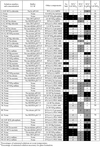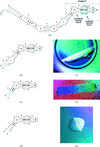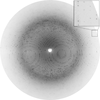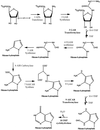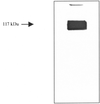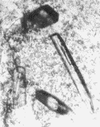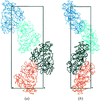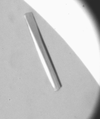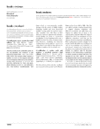issue contents
August 2000 issue

Cover illustration: Nucleotide-binding domain of P. falciparum GDP-bound Rab6. Ribbon drawing highlighting consensus sequences (p. 937).
research papers
The 2.3 Å resolution structure of the nucleotide-binding domain of P. falciparum Rab6 in GDP-bound form was determined using the MAD phasing technique.
PDB reference: PfRab6t, 1d5c
The crystal structure of the Fab fragment from the monoclonal anti-preS2 antibody has been solved by molecular replacement and refined at 3.0 Å resolution.
PDB reference: F124 Fab fragment, 1f11
Tetragonal lysozyme crystals have been grown at pH 8.0 using MPD as a precipitant. The observed difference in growth behaviour relative to the crystal form that grows at pH 4.5 in the presence of NaCl may be a consequence of the presence of a (4R)-MPD molecule bound between two lysozyme molecules in the crystal lattice.
The utilization of data collected on pseudo-merohedrally twinned crystals of a small protein for structure solution using multiwavelength anomalous diffraction is discussed and various phasing programs are compared.
Open  access
access
 access
accessA likelihood-based density modification approach is developed that can incorporate expected electron-density information from a wide variety of sources.
Laue data can now be processed in a nearly automated way. Soft-limited predictions significantly improve the quality of Laue data. A comparative study reveals that single-line undulators are the insertion devices of choice for time-resolved Laue experiments on macromolecules.
Rapid statistical quantitative sampling of crystal mosaicity is accomplished with a CCD detector and unfocused synchrotron source by collecting rotation data in superfine φ increments of 0.001°.
PDB reference: MnSOD, 1d5n
The use of lithium formate, lithium chloride and other highly soluble salts in suppression of the formation of crystalline or microcrystalline ice in macromolecular cryocrystallography is described.
The low-resolution molecular shape of superoxide dismutase determined from solution X-ray scattering data was located in the crystallographic unit cell by a molecular-search method. The absent reflections were replaced by randomly generated intensity values and a cluster analysis was used to select the solution.
Crystals of an antigen-binding fragment complexed with dT5 have been obtained and a molecular-replacement solution has been determined. AMoRe performed better than X-PLOR when using small search models.
crystallization papers
Three insect neurotoxins with analgesic effect from the scorpion B. martensii Karsch have been purified and crystallized in hexagonal, tetragonal, monoclinic and rhombohedral forms. Preliminary X-ray data are presented.
Crystals of a designed Rop variant have been obtained and X-ray data have been collected to a resolution of 0.8 Å.
Rab6 GTPase from the organism responsible for causing malaria, P. falciparum, has been expressed, purified and crystallized in two different forms. Preliminary crystallographic data have also been obtained.
S. cerevisiae Δ3-Δ2-enoyl-CoA isomerase has been crystallized and a native data set has been collected at 2.5 Å.
C. botulinum neurotoxin B has been crystallized and native data have been collected to 1.8 Å resolution.
Crystals of C. thermocellum xylanase Z feruloyl esterase have been obtained that diffract to 2.4 Å resolution. The lattice is orthorhombic, space group P212121, with unit-cell parameters a = 43.14, b = 63.77, c = 79.57 Å.
One of the proteins from the prokaryotic signal recognition pathway, FtsY, has been studied and results are presented here. Four versions of the FtsY receptor protein from M. mycoides have been cloned, expressed in E. coli and purified. Purified proteins were then subjected to crystallization trials and preliminary data obtained.
Crystals are described of the conserved domain IV of E. coli 4.5S RNA, which together with Ffh protein constitutes the bacterial signal recognition particle (SRP) and, by independently binding to elongation factor G (EF-G), also plays an essential role in ribosomal translocation.
A crystallizable form of the RIIβ regulatory subunit of PKA was obtained by limited proteolysis of the full-length subunit. Orthorhombic crystals were grown which diffracted to 2.3 Å.
Crystals of the Rho-binding domain of Rho-kinase were obtained in both native and selenomethionyl forms. The crystals belong to the space group C2 [a = 148.0 (2), b = 26.1 (1), c = 39.6 (1) Å, β = 90.3 (1)°] and diffract to a resolution beyond 1.5 Å.
The enzyme PdxJ, which is involved in synthesis of pyridoxine, has been crystallized in several forms under different conditions. The best crystals have undergone crystallographic analysis.
Recombinant maltosyltransferase from the hyperthermophilic bacterium T. maritima has been crystallized. The crystals belong to space group P4122 or P4322 and diffract to at least 2.4 Å resolution.
Crystals of the de novo purine biosynthesis enzyme ATIC in complex with methotrexate have been obtained. X-ray data have been collected to 2.3 Å at Stanford Synchrotron Radiation Laboratory.
Vinculin, an important protein in the maintenance of the actin cytoskeleton and cell–cell adhesion, has been isolated from smooth muscle, and crystals have been obtained.
An extracellular β-xylosidase from T. reesei has been purified and crystallized. The crystal belonged to an orthorhombic space group and diffracted to 2.7 Å resolution.
The catalytic trimer of M. jannaschii aspartate transcarbamoylase has been crystallized. The work leading to the determination of its structure by molecular-replacement and Patterson methods is described.
Apocrustacyanin A1 is a 20 kDa subunit of the blue lobster carapace carotenoprotein α–crustacyanin, which provides the animal with cryptic colouration, is a member of the lipocalin superfamily and whose bathochromic spectral shift of the bound carotenoid is of similar magnitude to that for retinal in the visual pigments. Data recorded using softer X-rays (2.0 Å wavelength) are also reported as a strategy to tackle the challenge of 40 kDa in the asymmetric unit.
short communications
A complex of the influenza virus haemagglutinin trimer with the Fab of a neutralizing antibody has been shown to have a 1:2 stoichiometry. Diffraction data were collected to 3.5 Å resolution and the initial structure was solved by molecular replacement.
Analysis of the bulk-solvent correction parameters (Bsol, ksol) obtained from 219 crystal structures deposited with the PDB shows that current refinement methods fail to uncouple the two parameters, resulting in values that have no physical meaning.
Molecular-replacement studies of T. kirilowii lectin 1 show that its structure belongs to the family of type 2 ribosome-inactivating proteins.
The integral membrane protein cytochrome bo3 ubiquinol oxidase was crystallized in space group C2221, with cell dimensions a = 91.3, b = 370.3 and c = 232.4 Å. A clear molecular-replacement solution was obtained.
Orthorhombic lysozyme crystals grown in a high magnetic field showed improvements of both higher resolution and lower mosaicity for X-ray analysis.
books received
Free 

Free 



 journal menu
journal menu


















